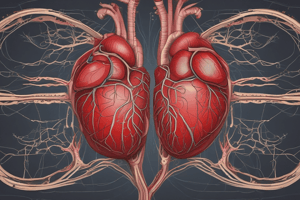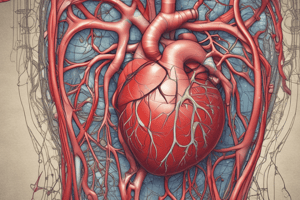Podcast
Questions and Answers
What is the function of the right ventricle?
What is the function of the right ventricle?
- Pumps blood from the right atrium to the rest of the body
- Receives oxygenated blood from the lungs
- Receives deoxygenated blood from the body
- Pumps blood from the right atrium to the lungs (correct)
What occurs during diastole?
What occurs during diastole?
- Heart muscle contracts, chambers pump blood out
- Blood flows from the left atrium to the left ventricle
- Heart muscle relaxes, chambers fill with blood (correct)
- Blood is pumped from the right ventricle to the lungs
What is the purpose of the mitral valve?
What is the purpose of the mitral valve?
- Pumps blood from the right ventricle to the lungs
- Receives deoxygenated blood from the body
- Separates the right atrium and ventricle
- Separates the left atrium and ventricle (correct)
What is the average heart rate?
What is the average heart rate?
What does the P wave represent on an ECG?
What does the P wave represent on an ECG?
What system regulates blood pressure through hormonal changes?
What system regulates blood pressure through hormonal changes?
What is cardiac output?
What is cardiac output?
What is the average cardiac output at rest?
What is the average cardiac output at rest?
Flashcards are hidden until you start studying
Study Notes
Heart Structure
- The heart is a muscular organ that pumps blood throughout the body
- Composed of four chambers:
- Right atrium (receives deoxygenated blood from the body)
- Right ventricle (pumps blood from the right atrium to the lungs)
- Left atrium (receives oxygenated blood from the lungs)
- Left ventricle (pumps blood from the left atrium to the rest of the body)
Blood Flow
- Deoxygenated blood enters the right atrium through the superior and inferior vena cavae
- Blood flows from the right atrium to the right ventricle through the tricuspid valve
- Blood is pumped from the right ventricle to the lungs through the pulmonary valve
- Oxygenated blood returns to the heart through the pulmonary veins and enters the left atrium
- Blood flows from the left atrium to the left ventricle through the mitral valve
- Blood is pumped from the left ventricle to the rest of the body through the aortic valve
Cardiac Cycle
- Diastole: heart muscle relaxes, chambers fill with blood
- Systole: heart muscle contracts, chambers pump blood out
- One complete cycle of diastole and systole is called a heartbeat
- Heart rate: number of heartbeats per minute (average: 70-80 bpm)
Electrocardiogram (ECG)
- Measures electrical activity of the heart
- P wave: atrial depolarization (contraction)
- QRS complex: ventricular depolarization (contraction)
- T wave: ventricular repolarization (relaxation)
Blood Pressure Regulation
- Baroreceptors: sensors in blood vessels that detect changes in blood pressure
- Vasomotor center: regulates blood pressure by controlling vasodilation and vasoconstriction
- Renin-angiotensin-aldosterone system: regulates blood pressure through hormonal changes
Cardiac Output
- Amount of blood pumped by the heart per minute
- Calculated by multiplying heart rate and stroke volume (amount of blood pumped per beat)
- Averages 5-6 liters per minute at rest
Heart Structure
- The heart is a muscular organ that pumps blood throughout the body
- It has four chambers: right atrium, right ventricle, left atrium, and left ventricle
- Right atrium receives deoxygenated blood from the body through superior and inferior vena cavae
- Right ventricle pumps blood to the lungs
- Left atrium receives oxygenated blood from the lungs through pulmonary veins
- Left ventricle pumps blood to the rest of the body
Blood Flow
- Deoxygenated blood enters the right atrium through superior and inferior vena cavae
- Blood flows from right atrium to right ventricle through tricuspid valve
- Blood is pumped from right ventricle to lungs through pulmonary valve
- Oxygenated blood returns to the heart through pulmonary veins and enters the left atrium
- Blood flows from left atrium to left ventricle through mitral valve
- Blood is pumped from left ventricle to the rest of the body through aortic valve
Cardiac Cycle
- Diastole is the heart muscle relaxation phase, where chambers fill with blood
- Systole is the heart muscle contraction phase, where chambers pump blood out
- A complete cycle of diastole and systole is called a heartbeat
- Heart rate is the number of heartbeats per minute, averaging 70-80 bpm
Electrocardiogram (ECG)
- Measures electrical activity of the heart
- P wave indicates atrial depolarization (contraction)
- QRS complex indicates ventricular depolarization (contraction)
- T wave indicates ventricular repolarization (relaxation)
Blood Pressure Regulation
- Baroreceptors detect changes in blood pressure
- Vasomotor center regulates blood pressure by controlling vasodilation and vasoconstriction
- Renin-angiotensin-aldosterone system regulates blood pressure through hormonal changes
Cardiac Output
- Cardiac output is the amount of blood pumped by the heart per minute
- Calculated by multiplying heart rate and stroke volume (amount of blood pumped per beat)
- Averages 5-6 liters per minute at rest
Studying That Suits You
Use AI to generate personalized quizzes and flashcards to suit your learning preferences.





